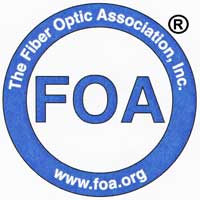

October
2020
|
Search the FOA website
FOA
Home Page Contact
Us
|
Sign
up for the FOA eMail Newsletter
Privacy
Policy
Sections
News
Technical Worth
Reading Q&A
Training/FiberU
Resoures
Safety
About
|
- In
This Issue
- Note
we have changed the format to place articles in
sections on one topic and all articles are dated so
you know if we repeat one - whcih we often do when
we think it's very important!
3
More New Fiber U MiniCourses.
2 New FOA YouTube Videos.
FOA Certs For Experienced Techs Done Online
Great Ideas -
DUDC - Motorozed Underground Vault
Microtrenching Street Savers
RayDius Bend Radius Block
History, From Peter Morcombe
More
Newsletter
Sections
Click
on any link to jump to that section
News
COPPER IS DEAD - AT&T Declares, Verizon Movie on 5G,
5G lie, AT&T Plans, Tight Cable Fit, Broadband Study,
New Products
Technical
Total internal reflection , the mystery of
loss in dB solved, splices on OPGW, manufacturers of
prepolished connectors, more
Worth
Reading Damage Protection, Passive
Optical LANs, more
Q&A
As usual, new questions
Training/FiberU
New schools, remote OTDR for training, making
training classroom safe, onine training, materials, more
Resoures
Safety
About
FOA Certifications:
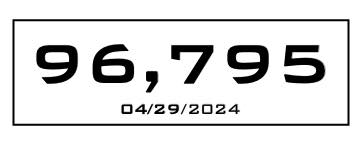
Time
To Renew Your FOA Certifications?
Special
offer - 1/3 Off Renewal
Jobs
- See
FOA Jobs
Web Page and FOA on

- The
FOA Jobs
Web Page has been updated and a new page added on Using
your FOA Training/Certification to Find the Right Job
in Fiber Optics
Where
Are The Jobs In Fiber Optics? FOA talks about all the
applications for fiber optics, what jobs involve and the
qualifications for the workers in the field in this YouTube
video.
Join
The FOA eMail Newsletter List
Want to
be notified when the FOA Newsletter is updated? Sign
up for the FOA eMail Newsletter. You can also
sign up from your cell phone: text "FOA" to 22828 (usual
text message charges apply)
Trademarks:
The FOA CFOT® (Certified Fiber Optic Technician) and
Fiber U® (the FOA online self-study program) are registered
trademarks of the FOA.

Want
to know more about fiber optics? Study
for FOA certifications? Free
Self-Study Programs are on "Fiber
U®." Looking for specific information? Here's the
largest technical reference on the web: The
FOA Online Fiber Optic Reference Guide.
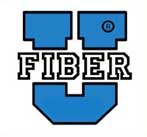
Free
online self-study programs on many fiber optics and cabling
topics are available at Fiber
U, FOA's online web-based training website.
FOA
Reference Books
Available Printed or eBooks
The
fiber book is available in Spanish and French
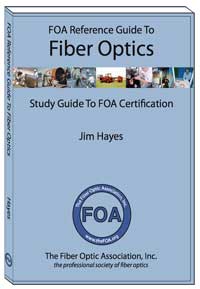
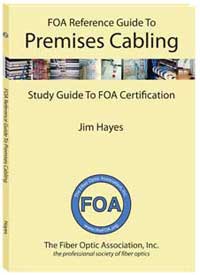
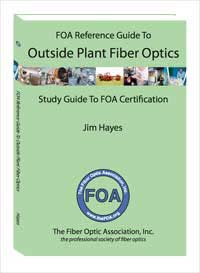
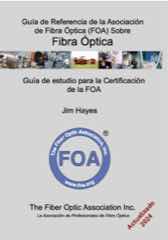
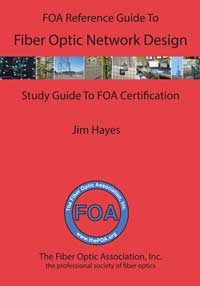
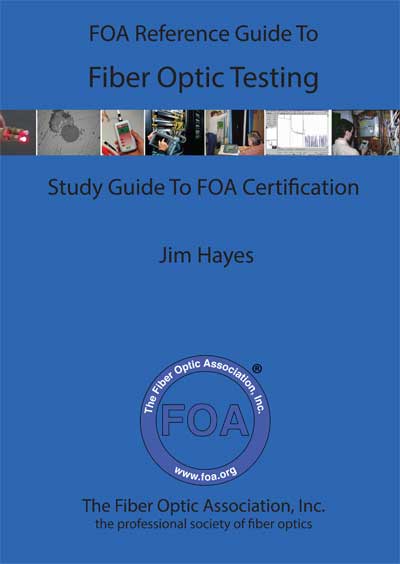
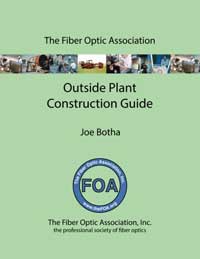
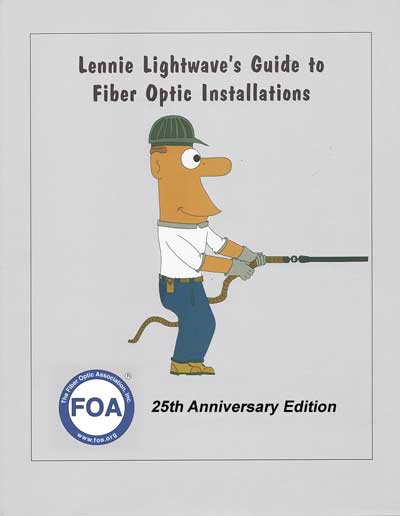
Lennie
and Uncle
Ted's Guides are now also available as free iBooks on
iTunes.
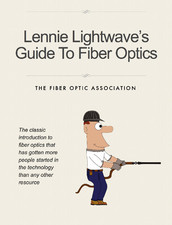
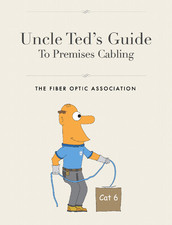
Click
on any of the books to learn more.
- Fiber
Optic Safety Poster to download and print
FOA
Videos on 
FOA
is a member of:




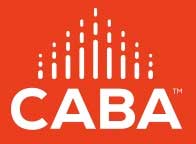
The
FOA Newsletter is edited by Jim Hayes - send your stories,
leads, ideas, comments to <jim @ foa.org>

Search
the FOA Website With DuckDuckGo
- The
Archives: Past Issues.
- Use
these links to read past issues or use FOA's
Custom Search to look for specific topics on our
website.
1/20,
2/20, 3/20.
4/20, 5/20,
6/20, 7/20,
8/20, 9/20,
10/20,
1/19,
2/19, 3/19,
4/19,
5/19, 6/19,
7/19, 8/19,
9/19, 10/19,
11/19,
12/19
1/18,
2/18, 3/18,
4/18, 5/18, 6/18,
7/18, 8/18,
9/18, 10/18,
12/18.
1/17,
2/17, 3/17,
4/17, 5/17,
6/17, 7/17,
8/17, 9/17,
10/17, 11/17,
12/17
1/16,
2/16, 3/16,
4/16,
5/16, 6/16,
7-8/16, 9/16,
10/16, 11/16,
12/16
1/15,
2/15, 3/15,
4/15, 5/15,
6/15, 7/15,
8/15, 9/15
, 10/15,
11/15 , 12/15
1/14,
2/14, 3/14,
4/14, 5/14,
6/14, 7/14,
8/14, 9/14,
10/14, 11/14,
12/14
1/13,
2/13, 3/13,
4/13, 5/13,
6/13, 7/13,
8/13, 9/13,
10/13, 11/13,
12/13
1/12
, 2/12, 3/12,
4/12, 6/12,
7/12, 8/12,
9/12, 10/12,
11/12, 12/12
1/11
, 2/11,
3/11,
4/11,
6/11, 7/11,
8/11, 9/11,
10/11, 11/11,
12/11,
1/10
, 2/10,
3/10, 4/10,
05/10,
07/10,
08/10, 09/10,
10/10,
11/10
1/09
, 2/09,
3/09, 04/09,
05/09,
07/09,
08/09, 09/09,
10/09, 11/09,
12/09
1/08
, 2/08, 3/08,
4/08, 5/08,
6/08, 7/08,
8/08, 09/08, 10/08,
11/08, 12/08
12/07 , 11/07,
10/07, 09/07,
08/07, 07/07,
06/07, 05/07,
04/07, 03/07,
2/07, 1/07
12/06
, 11/06, 10/06,
09/06, 8/06,
7/06, 6/06,
5/06, 4/06,
3/06, 2/06,
1/06,
12/05
,11/05, 10/05,
09/05, 08/05,
07/05, 6/05,
5/05, 4/05,
2/05, 01/05,
12/04
, 10/04, 9/04,
8/04, 7/04,
6/04, 5/04,
4/04, 3/04,
1/04,
12/03
, 11/03 10/03
9/03, 8/03,
7/03, 6/03,
3/03, 10/02
, 8/02, 5/02
Current Issue of FOA Newsletter
Time
To Renew Your FOA Certifications?
To keep
your FOA certifications active, you need to renew them when
they expire. Now we have a new more convenient way to renew
- an online store at Paypal - where you can quickly and
conveniently use your PayPal account or your credit card to
renew your certifications.
- You
can now renew with PayPal or a credit card
-
PayPal
is available worldwide
Join
FOA On Social Media

FOA has
four LinkedIn Groups
FOA
- official page on LinkedIn
FOA
- covers FOA, technology and jobs in the fiber optic
marketplace
FOA
Fiber Optic Training - open to all, covers fiber optic
technology and training topics
Grupo
de La Asociación de Fibra Óptica FOA (Español)
SPECIAL
OFFER - Save 1/3 On Your Certification Renewal Cost
In the
near future, there will be a requirement for continuing
education to renew your FOA certifications. FOA is testing
an option for renewals where you take a short Fiber U online
course.
If you would like to help FOA test this option, you can save
1/3 the cost of your renewal. Go
here to take the Fiber U CFOT Renewal Course: |
FOA
Newsletter - Features
3
More New Fiber U MiniCourses

Got
An Hour Or Less? Learn Something New About Fiber Optics.
Last
month we introduced a new type of Fiber
U
course, the MiniCourse, a free online course you could take
in a short time, perhaps as you ate lunch at your desk or
took a long coffee break. This month we added 3 more
courses:
Fiber
Optic Cable Bend Radius
Fiber
Optic Link Loss And Power Budgets
Fiber
Optic Connector Inspection And Cleaning
The topics of these three courses should explain what they
are about, and these are all very important topics to fiber
optic techs.
The courses have two components, video lectures and
readings, that are complementary. As usual there is a
self-test to allow you to check your comprehension. As with
other Fiber U courses if you desire, you can take a short
test for a Fiber U Certificate of Completion that costs
only $10.
The three MiniCourses introduced last month are "Fiber
Optic Restoration,' Connector Identification" and "The
Mysterious dB of Fiber Optics."
Fiber
Optic Network Restoration
Fiber
Optic Connector Identification
The
Mysterious dB of Fiber Optics
All these free courses and many more are
available at Fiber
U.
2
More New FOA Video Lectures On YouTube
As part
of developing the new Fiber U MiniCourses, we added 2 new
YouTube videos also, in addition to the 5 new videos added
last month:
Lecture 56 explains the issues of cable bend radius
limitations, typical cable specifications and how to gage
the proper radius or diameter when installing or storing
cable. Lecture 57 covers problems with dirty connectors and
how to inspect and clean them.
Videos
added last month:
FOA
Lecture 51 Fiber Optic Restoration
Part 1 - Causes of Damage To The
Network
FOA
Lecture 52 Fiber Optic Restoration Part 2 -
Planning For Restoration
FOA
Lecture 53 Fiber Optic Restoration Part 3 -
Troubleshooting And Repair
FOA
Lecture 54 Fiber Optic Connector Identification
- New and old
FOA
Lecture 55 The Mysterious dB of Fiber Optics.
- Understanding dB
Lectures 51, 52 and 53 are about fiber optic
network restoration, broken into 3 parts: what
causes damage, how to plan for restoration and
finally troubleshooting and repairing a network
outage. Lecture 54 is a short history of the
development of fiber optic connectors and a
overview of the ones most used today. Lecture 55
will teach you about dB, it's origin, an
explanation of the math behind it and why
standards can make it confusing.
Like all our YouTube lectures, they are all short
and easy to understand.
FOA
"Work-To-Cert" Program
Experience
Plus Online Study At Fiber U = FOA Certification
This
year, more techs have become comfortable with online
conferences, webinars and training. Many have discovered
that they can become FOA Certified using their experience in
fiber optics and study for the FOA certification exams
online at Fiber U.
Thousands
of industry professionals have applied to the FOA directly
for certification without the need for classroom training,
based on their knowledge and skills developed working the
field. Since FOA certifications are based on KSAs
(knowledge, skills and abilities), current techs already
show the skills and abilities required through their field
experience. FOA provides free online self-study
courses at Fiber U
for the knowledge part to prepare you for FOA certification
exams which you can also take online.
If you are an experienced field tech interested in
certification, and FOA is the internationally
recognized certifying body for fiber optics, you can find
out more about the FOA
"Work to Cert" program here.
If you are already a CFOT, FOA also offers many specialist
certifications you can obtain based on your experience as a
field tech. See what's available at Fiber
U.
GREAT
IDEAS!
Two
great ideas (and one good one too) for products came to our
attention this month.
MetroFibre
DUDC - Dry Underground Distribution Chamber
FOA
Instructor Joe Botha in South Africa told us about this DUDC
- Dry Underground Distribution Center - underground
distribution rack developed by MetroFibre
in SA for their own use and not available commercially.
MetroFibre's Johan Booysen, Optical Assurance Manager,
provided this description:
"Metrofibre currently utilize these in instances where the
municipality don’t allow SDC’s (single door distribution
cabinets) and where the risk of damage could be high. You
will see that the pictures I took are relevant to my
training center and pre-populated already. Don’t mind the
different high density patch panels, I populated it this way
relevant to what we could utilize in the field."

Front view in the MetroFibre lab above and rear view below.
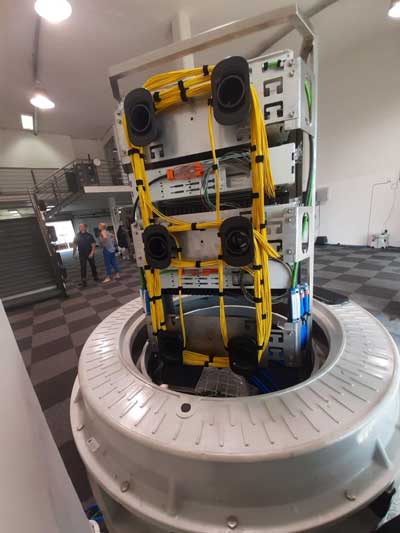
But the movie below shows the really neat part of the idea,
it has a "elevator" feature that allows it to be raised and
lowered into the special sealed handhole.
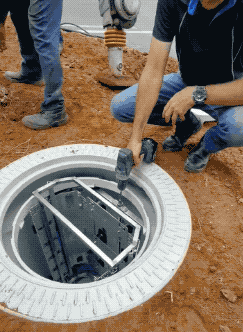
As we said, this is custom for MetroFibre and not available
commercially. However we bet such a good idea won't take
long to become a commercial product!
U-TECK
Street Savers - Microtrench Protectors
Microtrenching
has become a very popular technique for installing fiber
optics because it's fast, inexpensive and creates less
disruption during construction. Sometimes during the process
of microtrenching there is a need to leave an open trench
for a short period of time before cable installation and
backfilling. During that time, there is a possibility of
vehicles driving over it, and it needs protection. For this,
U-TECK developed Street Savers.
Street Savers are short lengths of high strength plastic
(HDPE) with fins that drop in the microtrench groove to hold
them in place. If they have to be left for longer periods
like overnight or has higher speed traffic, there are holes
provided to allow screwing them into the pavement. Two
lengths are available and the joints are moveable to allow
them to follow curves.
Here are Street Savers being used on a suburban street:
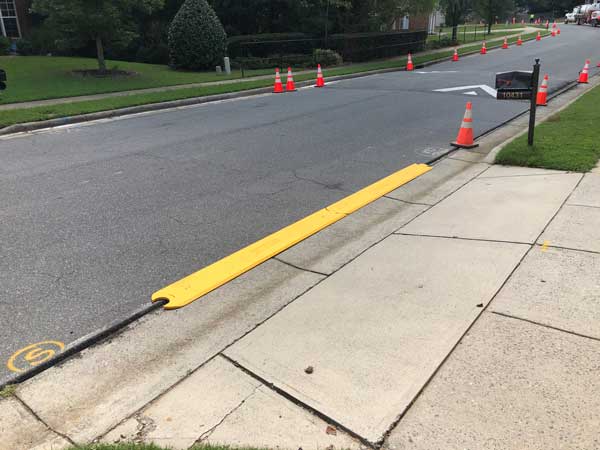
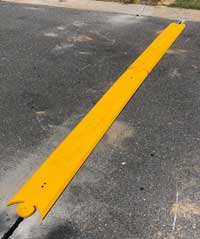
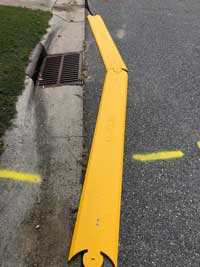

Note how the flexible joint allows them to follow curves.
Go
here for more information on U-TECK Street Savers.
And we also suggest you look at U-TECK's RayDius Fiber
Quadrant Block for pulling fiber optic cable without damage
caused by violating the cable minimum bend radius.
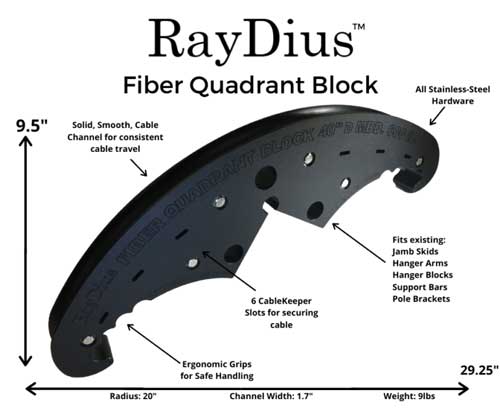
If you don't know what this is used for, you need to take
the
Fiber U MiniCourse on Bend Radius or watch the new Bend
Radius video on YouTube.
History
- From Those Who Lived It
By
Peter Morcombe, FOA Master Instructor, Retired
Yesterday I “Skyped” my friend Frances who lives in
Canberra, Australia and we spent fifteen minutes swapping
information about our children. The quality of the
video was amazing but even more remarkable, the call was
free of charge! So how is it that
intercontinental video calls are “Too Cheap to Meter”?
In 2018, Telefónica, a Spanish company, opened a submarine
cable called MAREA from Virginia Beach to Sopelana in
northern Spain. The capacity was 160 Tera-bits per
second, equivalent to 2.5 billion simultaneous digital phone
calls!
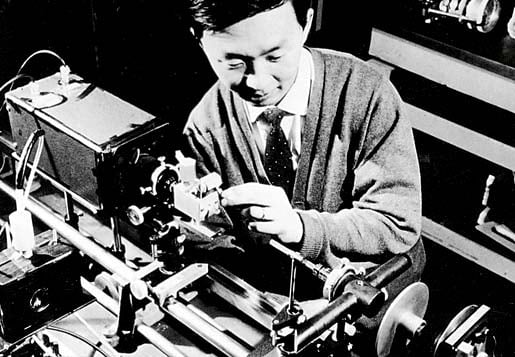
Dr. Charles KAO at STL in 1965
This amazing cable rests on an invention that led to Charles
Kao being awarded the 2009 Nobel prize in
physics. His invention affects the lives of every one
of us every single day yet you have never heard his
name. Charlie invented the high performance optical
fiber that makes those free video calls possible. Yet
the first inter-continental optical cable was installed only
32 years ago. It is scary to realize how profoundly
scientists can affect our lives for good or for ill.
The first intercontinental fiber optic cable was called
TAT-8 (TransAtlantic Telecommunications, cable #8) with only
40,000 telephone channels. It cost $335 million when it
entered service in 1988. Even though optical fibers
have very low loss the cable was over 3,000 miles long so
more than 60 signal regenerators were needed. The
regenerators were built by AT&T. The cable itself
was manufactured by Standard Telephones & Cables a
subsidiary of the ITT corporation.
The prototype of that cable was installed in Loch Fyne near
Glascow, Scotland ten years earlier. That cable was
built by at STL (Standard Telecommunications Laboratories)
in Harlow which is roughly 20 miles north of
London. The same year (1978), STC built a fiber
optic factory in Harlow since the demand for fiber had grown
beyond what Charlie’s team of researchers could produce.
Charlie’s team at STL installed the first high speed fiber
optic data system in 1975 for the Dorset Police. Two
years later a fiber optic link was installed from Hitchin to
Stevenage, a distance of roughly 10 km. The system had
two regenerators and it is probably the only high
performance system to use multimode optical fiber. The
fiber was unusual since it had a core diameter of 40 microns
and a cladding of 100 microns. The link remained in
service with British Telecom for many years with a capacity
of 1,920 telephone channels or two 70 Mbit/second digital TV
channels.
In 1968 Charles Kao and M.W. Jones published a paper
describing optical fiber with a loss of 4 decibels per
kilometer and that was considered an outstanding achievement
considering that most coaxial copper cables have five times
higher loss while offering only a tiny fraction of the
bandwidth of optical fiber.
So how do I know all this? I worked with Charles Kao
to build and manage that 1978 optical fiber factory.

Peter
Morcombe joined BDI Datalynk as an FOA instructor
in 2007 after a long career in lasers and fiber optics
including working in the UK with fiber pioneers Charles
Kao and David
Payne and projects like TAT-8, the first fiber
optic transatlantic fiber optic cable. He retired
recently.
1995-2020
- FOA's 25th Anniversary!
As part
of celebrating 25 years of serving the fiber optic industry
as its primary source of technical information and
independent certifying body, FOA thought it appropriate to
create a short history of the organization and how it has
developed to help the fiber optic industry. We also
wanted to recognize the contributions many people have made
to the organization over the years that made FOA what it is
today.
The FOA history is now archived on the FOA website where
you can read it anytime or link to it.
Updated
info - dB, total internal reflection and science projects,
In
Case You Missed The Last FOA Newsletter
You can
still read these feature articles in the last issue:
FOA
Turns 25.
Projects For Teachers, Kids
and Parents.
Winter
Installations.
Mystery
Connectors.
The Cost of
Connectivity.
Replacing A
Utility Pole.
FOA
Newsletter Sections
News
Technical Worth
Reading Q&A
Training/FiberU
Resoures
Safety
About
|
News
|
Headlines
That Got Our Attention: (October 2020 FOA Newsletter)
COPPER
IS DEAD! AT&T No Longer Will Sell DSL Services
AT&T ditches DSL Stephen Hardy, Lightwave,
October 5, 2020
AT&T (NYSE: T) has informed subscribers that it will no
longer accept new orders for DSL-based services. The change,
effective October 1, was communicated to subscribers in a
billing notice this past summer. The company has posted a
confirming statement on its website among its service
descriptions.
In a statement sent to Fierce Telecom, AT&T said that
existing customers could retain their service or switch to a
fiber-backed service, where available. Service based on
fixed wireless access also may be available, depending upon
the service area.
While AT&T has consistently emphasized its plans to
invest in its broadband networks, those plans center on 5G
and fiber-optic network infrastructure.
“Priority #1 is to make sure that we're investing in our
core businesses, and that's fiber and making sure that we
have broadband connectivity on 5G,” said John T. Stankey
AT&T CEO and director at a virtual Goldman Sachs
conference in August. “And when you think about it, those
two aren't dissimilar. When you have a great 5G network,
you're deploying a lot of fiber, and that's something that
we think are married well. And we think we're in a very
unique position because the fiber that we deploy, not only
powers our wireless business, but it helps our consumer
business and fixed broadband. It helps our enterprise
customers and how we deal with them as well, and so we
strategically want to make sure we're doing that.”
AT&T reported 469,000 DSL customers at the end of its
fiscal second quarter (June 30, 2020), a drop of 23,000 from
the previous quarter and nearly 300,000 less than totals on
June 2018. The company reported 4.3 million fiber internet
users in the most recently reported quarter.
2nd
Opinion
AT&T
Is Abandoning Tens of Thousands of American Households in
the Deep South Who Have No Other Internet Access Option ILSR
Community Networks
All across the country, municipal networks, cooperatives,
and cities have been putting in extra effort to make sure
that Americans have the fast, affordable, reliable Internet
access they need to conduct their lives in the midst of the
COVID-19 pandemic.
AT&T has decided to take another route. A USA Today
report last week revealed that the company has stopped
making connections to users subscribing to its DSL Internet
as of October 1st. Anyone calling the company to set up new
service is being told that no new accounts are being
accepted.
The decision comes right as the National
Digital Inclusion Alliance has released a report
detailing that only 28% of AT&T’s territory can get
fiber from the company. AT&T has deliberately focused
investment in more urban areas of higher income. From the
report:
"The analysis of AT&T’s network reveals that the company
is prioritizing network upgrades to wealthier areas, and
leaving lower income communities with outdated technologies.
Across the country, the median income for households with
fiber available is 34 percent higher than in areas with DSL
only — $60,969 compared to $45,500."
Verizon
Goes To The Movies To Promote 5G (October 2020)
In the
last FOA Newsletter, we quoted from the article
below from the Washington Post Sept 8 about the slow
speed of 5G today. The
article had an interesting comment: Verizon, the largest
U.S. wireless carrier, has announced it also will launch a
low-band 5G network by the end of the year. And at least
to investors, Verizon’s CEO also has been blunt about the
incremental improvements nationwide 5G will offer over 4G.
“In the beginning, it’s going to be small,” Hans Vestberg
told a JPMorgan conference in May.
Less
than two weeks later, the Sunday NYTimes Magazine ran 6 full
page advertisements by Verizon promoting 5G and inviting you
to watch a "documentary" they made on 5G on Netflix called
"Speed of Thought." (Details
from Verizon and the
movie website,)

Do not
confuse this Verizon effort with the Sci
Fi B-movie of 2011 by the same name which got a 15%
rating on Rotten Tomatoes! But is the Verizon
movie a documentary as they call it, a infomercial or just
science fiction?
The Verizon movie showed people working on projects that
they imply will be assisted by 5G wireless or maybe not
possible without them at all. The intended audience was
certainly not technical people, since there were many
instances where we noticed problems with the narrative. For
instance:
Nowhere in the whole movie did they mention fiber optics -
even when one participant was using his mobile phone on the
street to call his parents in Italy. The movie showed
diagrams of the network connecting him to Italy but no
mention of the fact that the network was all fiber, perhaps
leaving the typical person to assume it was all 5G wireless?
Absolutely nothing they discussed would work without fiber
optics.
The medical app they showed implied that medical devices
including a robot would connect on 5G and work right. Why
not a fiber tether with more bandwidth and EMI resistance
since it was working around all sorts of medical devices
like a X-ray machine. What happens around MRI or PET
machines? And the idea was the robot in remote hospitals
could benefit from doctors in major hospitals, but how could
a rural hospital afford such an expensive piece of equipment
- typically several million dollars?
The educational app featured would be unlikely to use 5G
inside a school since they rely on WiFi for wireless.
The connections for the fireman using the IR headset were
not explained, but if 5G is on millimeter wave bands, it's
not likely to get in/out of a building, and certainly a
shipping container as one demo used.
The section on auto safety did not mention that those
applications are long in the future and cellular technology
is updated and obsoleted much faster than the lifetime of
cars. Lexus
announced recently that they were abandoning owners
with 2G cellular connected vehicles only 4 to 10 years old,
shutting down their vehicles call for help services. .
The references to urban kids never mentioned the likelihood
of installing 5G into their neighborhoods or cost of phones
and service which is much higher than normal cellular.
Which brings us to an interesting question. Why did
Verizon spend about a half-million dollars on ads in the
NY Times magazine and probably that much more making this
movie? Probably to impress investors and maybe consumers,
but would all that money have been better spent, and
produce better PR, by connecting several thousand
low-income homes in the NY City area with fiber. We sent
letters to the NYTimes tech columnists and Verizon PR but
got no response. Ed.
And this just in...."Verizon forced to pull ad that
claimed firefighters need Verizon 5G" Ars
Technica
In
case you missed it last month....
"The
5G lie: The network of the future is still slow"
(September 2020)
(Washington
Post, Sept 8, 2020)
"The
Washington Post speed tested 5G phones against 4G ones.
America’s new nationwide 5G networks weren’t much faster —
and in some places they were slower."
The Post reporter Geoffrey A. Fowler carried 6 phones, a
year old 4G/LTE phone and 5G phones from the major carriers
around the San Francisco Bay Area and ran speedtests on each
phone, over 4000 tests in total. He found 5G speeds were
roughly the same as 4G/LTE and some places slower. AT&T
speeds were about the same, as was T-Mobile speeds, but
Verizon coverage was not available in the Bay Area where he
tested the phones.
"AT&T
and T-Mobile both market their 5G networks as
“nationwide,” though they carefully dance around speed
claims. AT&T says 5G means “improved speed” and
T-Mobile says “faster speed,” without many specifics.
Verizon does make extreme-speed claims about its 5G
network — it’s “25x faster than today’s 4G” — but it is,
as of this summer, available in less than 1 percent of the
country."
Fowler went on to say "When I asked executives at the
networks about speed, they acknowledged a truth their
advertisements carefully omit. “Our 5G experience initially
is as good or better than our 4G LTE experience,” said Chris
Sambar, AT&T’s executive vice president for technology
operations. Let that sink in: At least for now, 5G is … only
as good as 4G.
T-Mobile is equally circumspect, highlighting the range of
its coverage, not its jaw-dropping speed. “We’re not
claiming that this is where the story of 5G ends. It’s very
much a beginning,” said Mark McDiarmid, the senior vice
president for radio network engineering and development. He
said right now T-Mobile’s 5G network is “two times as fast”
as its 4G LTE nationwide average."
"When PC Magazine challenged AT&T about shortcomings of
its low-band 5G network in January, the company downplayed
speed. “We’ve been pretty vocal that early on there’s no
tremendous difference,” AT&T vice president Gordon
Mansfield said at that time."
"Verizon, the largest U.S. wireless carrier, has announced
it also will launch a low-band 5G network by the end of the
year. And at least to investors, Verizon’s CEO also has been
blunt about the incremental improvements nationwide 5G will
offer over 4G. “In the beginning, it’s going to be small,”
Hans Vestberg told a JPMorgan conference in May."
"I
told AT&T about both of our cases. It sent me a
different phone to test, but the result was the same. “You
are two data points,” said AT&T’s Sambar. “We’ve done a
lot of internal testing ... [and] we’re seeing our that our
5G network is showing speeds that are at least at parity
with LTE, if not better.”
"But for everyone else, waiting will bring down the cost of
great 5G phones. The extra time also will allow handset
makers to improve their hardware and software — and let
networks figure out how to make sure 5G phones don’t
actually feel like downgrades."
Remember the articles we've written on Space-X's plan to
fill the sky with satellites? Maybe ruining ground-based
astronomy, filling space with hazardous junk and even making
launches difficult? Well there is more.
Starlink,
the satellite Internet provider from Elon Musk’s SpaceX,
will be able to support just 485,000 simultaneous users at
100Mbit/s across the entire US, according to one firm’s new
estimates. And that kind of performance won’t even be
available until the end of 2026, when Starlink floods
Earth’s skies with up to 12,000 satellites.
According to the new estimates from the financial analysts
at Cowen, those figures mean that Starlink – a low Earth
orbit (LEO) satellite Internet operator that is expected to
begin offering a public beta service in November – won’t
pose much of a threat to established Internet service
providers like Verizon and Comcast.
“While Starlink has the ability to provide a practical
satellite-based broadband solution for the underserved, the
capacity has limitations in most of the US, especially
considering the growing demand for bandwidth driven by
in-home data-rich applications and devices,” the firm wrote
in a new report Wednesday.

CRU is holding its regular fiber optic markets conference
online this year. Intended for industry executives, it
explores innovative technologies as well as markets in
presentations by the leaders in the industry.
For
more infomation go to the CRU website.
AT&T
CEO John Stankey Lays Out the Company’s 4 Priorities
(September 2020)
AT&T’s
focus is on investing in its wireless and wired networks,
adding content to HBO Max, maintaining its dividend, and
paying down debt.
AT&T’s top priorities are investing in its wireless and
wired networks, adding content to HBO Max, maintaining its
dividend, and paying down debt, CEO John Stankey said on
Tuesday. The telecom and media company’s stock has been a
laggard in 2020 as investors fretted over its portfolio,
which is more-cyclically exposed than those of peers, and
its hefty debt load.
On the telecom side of the portfolio, laying fiber-optic
cable is first on the list for AT&T. It is killing
two birds with one stone, Stankey said at Goldman Sachs’
annual Communacopia media and telecom conference on Tuesday.
Next-generation 5G wireless networks are built on a fiber
backbone, with the wireless part being just hundreds of
yards between a customer’s phone and a cell tower. The
bulk of the traffic on the network travels over
fiber-optic cable. 5G-capable antennas and other
network equipment are also an investment focus.
Read
in Barron's - shared
from Apple News.
Tight
Fit: 6912 Fiber Cable Pulled in 1.25 inch Conduit
(September 2020)
Furukawa
Electric Co., Ltd. (FEC) conducted an experiment in its Mie,
Japan facility to demonstrate the installation of a
6912-fiber optic cable with an outer diameter of 1.14 inches
(29 mm) in a 696 foot (200m) long conduit with three 90
degree curves and an inner diameter of 32mm. The conduit
used was a standard product installed in conventional data
center campuses. Engineers confirmed a maximum pulling
tension of 84 pounds (372N), well below the maximum pulling
tension of 600 pounds (2700N) specified for the cable.
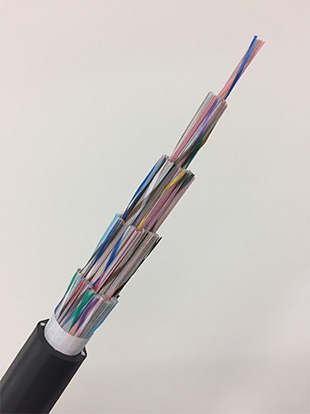 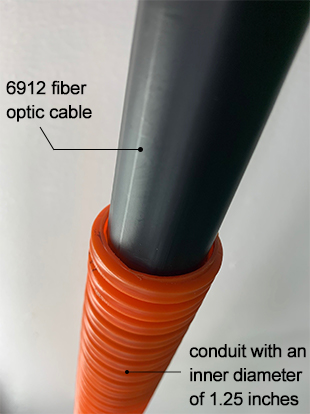
The cable was installed in a 1.25 inch (32mm) conduit with a
maximum length of 1,411 feet (430m) in a North American data
center campus in 2020 to support live traffic. The high fill
ratio in this application is not typically recommended for
Outside Plant (OSP) cable installation. However, in this
application, the end-user was willing to accept the
installation risk in return for maximum fiber density. The
installation demonstrated that FEC’s 6912 fiber optic cable
can be successfully installed into 1.25 inch (32mm) conduit
using appropriate tools, work procedures, and optimum
installation conditions.
“The FEC 6912 fiber optic cable at least doubled the fiber
count possible in a 1.25 inch conduit, compared to competing
available designs,” said Ichiro Kobayashi, General Manager
of optical fiber & cable engineering department, FEC.
Furukawa
PR also on OFS
Website. OFS is a FEC company.
New
Study Shows State Barriers to Community Networks Decrease
Broadband Availability - Community
Networks. (September 2020)
That
community networks act as a positive force in the broadband
market is something we’ve covered for the better part of a
decade, but a new study out in the journal
Telecommunications Policy adds additional weight (along with
lots of graphs and tables) which shows that states which
enact barriers to entry for municipalities and cooperatives
do their residents a serious disservice.
“State
Broadband Policy: Impacts on Availability” by Brian
Whitacre (Oklahoma State University) and Robert Gallardo
(Purdue University), out in the most recent issue of the
journal, demonstrates that enacting effective state policies
have a significant and undeniable impact on the pace of
basic broadband expansion in both rural and urban areas, as
well as speed investment in fiber across the United States.
The authors zero in on three particular policies that they
say have among the most significant impact on whether a
community has broadband or not: whether or not the state has
passed laws restricting municipalities and cooperatives from
building and operating broadband networks; whether or not
the state has a broadband office devoted to expansion and
staffed by full-time employees; and whether or not the state
has a funding program dedicated to expanding broadband
networks. Each of the above is considered against general
broadband availability at the national level, but also for
counties classified as rural.
Read
more: Community Networks
What
happens when you remove state barriers:
Mississippi Electric Co-ops Kick Broadband Projects Into
High Gear
Less than two years after Mississippi lifted its ban on
electric cooperative broadband networks, at least 15 of the
25 co-ops in the state have announced plans to provide
Internet access to members, with more on the way.
Read
more
Recycling
Fiber Optic Cable - Contact:
Steve Maginnis
LD4Recycle/ CommuniCom Recycling
(Visit
website)
sm@LD4Recycle.com
803.371.5436 |
Technical
On
fiber optic technology, standards, equipment,
installation, etc.
The
FOA Update Page
covers all the new technology and applications we covered
in this newsletter recently. Now you can review all that
new tech at once.

Want
to know more about fiber optics? Study
for FOA certifications? Free
Self-Study Programs are on "Fiber
U®." Looking for specific information? Here's the
largest technical reference on the web: The
FOA Online Fiber Optic Reference Guide.
Try
The FOA's New Online Loss Budget Calculator
FOA has
written many articles about loss budgets, something everyone
involved in fiber optics needs to know and needs to know how
to calculate. We've created a online Loss Budget Calculator
that does the work for you. Just input your cable plant data
and it calculates the loss budget. It works on any device,
especially smartphones and tablets for field use and even
allows printing the results.
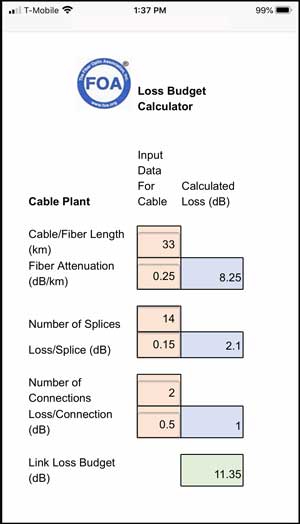
Bookmark
this page (especially on your smartphone: FOA
Loss Budget Calculator Online
|
How
Fiber Works - Total Internal Reflection - For Math
Lovers (August 2020)
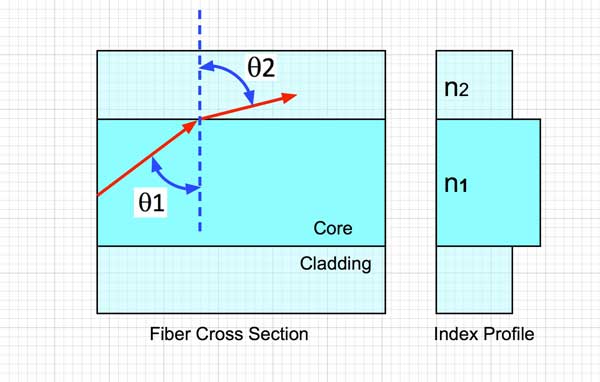
FOA has always had information on how fiber works using
total internal reflection, but we've recently updated our
web page on the subject to include a more complete
explanation using Snell's Law and the math that allows you
to calculate the parameters of the fiber including NA -
numerical Aperture.

FOA
Guide page on Total Internal Reflection
dB
or not dB, that is the question (8/2020)
FOA
has spent considerable space in this newsletter discussing
the confusion of dB measurements. FOA received a comment
from a very technical person we know who used to work for a
major fiber optic instrument manufacturer. He tries to
explain the issue thusly:
"I
submit that optical LOSS can be positive or
negative. I submit that optical GAIN can be positive
or negative. I submit that the CHANGE in optical
power (note that you use the word “change” in a dB
question below) can be positive or negative.
A negative Optical Loss is a gain. A positive
optical loss is a loss. Hence, Optical Loss
can either be positive or negative."
Redefining
relative dB measurements to make them read positive as was
done by some committee rewriting international standards
some years ago is simply ignoring the scientific community
and producing extreme confusion by making gain a negative
number. There is no problem making “loss” just “dB” with
no sign, as long as it’s known that it is represented by a
negative dB number. Likewise “gain” can have no sign as
long as it follows scientific and technical convention
which makes it a positive number.
We
have likened this to “profit” and “loss” in our
explanations. They use similar conventions. Does any
company talk about a negative profit? Of course not.
The
issue has always been the display of data on an OLTS
or OTDR. If instrument manufacturers had wanted to do
it right, instead of ignoring scientific convention
and changing the definition, they would have changed
displays to have no sign for loss or gain but for,
example, make gain readings flash, change color or
show “gain” on the display. There is a convention for
doing that in scientific instruments for readings that
are out of range or otherwise improper.
We
cannot accept under any circumstances that “gain” is a
negative number. Our scientific and technical
education revolts at that!
dBm
- Evidence 8/2020 -
We wanted to show a power meter that reads in both watts
and dB so you can see the correllation, so we found a 20+
year old meter that still had a scale reading in watts.
Here is an example of a power meter measuring in dBm and
microwatts (a microwatt is 0.001 or 1/1000th of a
milliwatt.)
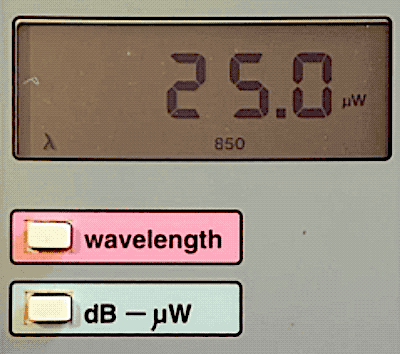
Here
is an example
of the
conversion of
watts to dBm.
This meter is
reading
25microwatts -
that's
0.025milliwatts.
If we convert
to dBm, it
becomes
-16.0dBm. We
can easily
figure this
out using dB
power ratios.
-10dBm is 1/10
of a milliwatt
or 0.100mW.
-6dB below
that is a
factor of 0.25
so 0.1mW X
0.25 = 0.025mW
or
25microwatts.
The other way
to figure it
is -10dB is
1/10 and -6dB
is 0.25 or
1/4th
(remember 3dB
= 1/2, so 6dB
= 3dB + 3dB =
1/2 X
1/2 = 1/4) so
-16dBm is
1/40milliwatt
or
0.025milliwatts
or
25microwatts.
Read a more
comprehensive explanation of dB here in the FOA
Guide.
Splice-On
Connector Manufacturers and Tradenames
7/2020
FOA Master Instructor Eric Pearson of Pearson
Technologies shared a list he has researched of
prepolished splice connectors with mechanical splices and
SOC - splice-on connectors for fusion splicing. This list
shows how widepread the availability of these connectors has
become, especially the SOCs and low cost fusion splicers.
Mechanical Splice
1. Corning Unicam® (50, 62.5, SM)
1. FIS Cheetah (???)
2. Panduit OptiCam® (50, 62.5, SM)
3. Commscope Quik II (50, 62.5, SM)
4. Cleerline SSF™ (50, SM)
5. LeGrand/Ortronics Infinium® (50, 62.5,
SM)
6. 3M/Corning CrimpLok (50, 62.5, SM)
7. Leviton FastCam© (50, 62.5, SM)
Fusion Splice
2. Inno (50, 62.5, SM)
3. Corning FuseLite® (50, SM)
4. FORC (50, 62.5, SM)
5. Siemon OptiFuse ™ (SM, MM)
6. Belden OptiMax?? FiberExpress (SM, MM)
7. AFL FuseConnect® (SM, MM)
8. OFS optics EZ!Fuse ™ (50, 62.5, SM)
9. Sumitomo Lynx2 Custom Fit® (50, 62.5,
SM)
10. Commscope Quik-Fuse (50, SM)
11. Ilsintech Pro, Swift® (50, 62.5, SM)
12. LeGrand/Ortronics Infinium® (50, 62.5,
SM)
13. Greenlee (50, 62.5, SM)
14. Hubbell Pro (50, SM)
15. Easysplicer (SM)
Note: There are additional manufacturers from the Peoples
Republic of China, which advertise on Amazon and eBay.
|
Worth
Reading
Each
month we read hundreds of newsletters and online articles.
These are the ones we think you will find "worth reading."
|
Worth
Reading: 10/20
Verizon
forced to pull ad that claimed firefighters need
Verizon 5G Ars
Technica
5G
May Lead To Less Accurate Weather Forecasts -
Rutgers U @ Futurity
Switch
to 5G Could Shut Down Millions of Connected Cars (LA
Times)
Starlink
Sattellites Severely Limited - 12,000 satellites for
less than 1/2 million users. (Light Reading)
Progress
on 25G PONs (Passive Optical Netowrks)
(Lightwave)
Read
a comprehensive
explanation of dB here in the FOA Guide.
Rattled
Louisiana Gulf Coast slammed by Hurricane Delta
- See how well aerial cables survive hurricanes - watch
the video aorund the halfway point.
Local
Broadband in America from Next Century Cities
Single
Pair Ethernet - explained by suppliers in Cabling
Installation & Maintnenace.
Installing
Prefab Cables for FTTH -
Corning FlexNAP™ System Installation in Pizzoferrato,
Italy
Good
Video On Coiling Cable For Storage Loops In Handholes
or Manholes - AFL. (More topics on page too)
Why
Wilson, N.C., Became Its Own Internet Provider -
NPR
How
much fiber optic cable is manufactured each year?
CRU Reports - unsurprisingly China is by far the largest
market today
9/2020
If
you are interested in restoration - aren't we all? -
you should also read this article in dpPro magazine
by FOA President Jim Hayes: Damage
Protection Requies Looking Overheas As Well As
Underground - dpPRO Magazine - about
the problems with aerial cables. His previous
article for the magazine was New
Techniques for Fiber Optic Installation.
Damage
Protection Requies Looking Overheas As Well As
Underground - dpPRO Magazine - FOA President
Jim Hayes writes about the problems with aerial cables.
APOLAN
claims passive optical LAN trims costs 56% over
traditional enterprise networks - CI&M
Fiber
Cleaning & Inspection--Best Practices by
Optotest
Break
Through Network Capacity Limits - Expand WDM or Faster
Speeds? - Lightwave
5
rules for placing fiber-optic cable in underground plant
- A new OFS technical guide covers comprehensive
steps for installation of fiber-optic cable in underground
plant.
CI&M
New
Study Shows State Barriers to Community Networks
Decrease Broadband Availability - Community Networks
Connecting
Residents in Boston, MA Next Century Cities
Rural
Telecom Funding Model Must Change ISE Magazine
Three
Applications Guides from Siemon: DAS, WiFi and AV
Lightmatter
- First Optical Processor Chip? - Lightwave
8/2020
“An
adequate connection is no longer a matter of convenience; it
is a necessity for anyone wishing to participate in civil
society,” wrote the New
York Times Editorial Board in an opinion article published
on Sunday, July 18.
The Institute
for Local Self-Reliance weekly newsletter has lots of
interesting articles and links.
"July has seen the release of complementary reports which
shed light on two of the topics we care about a great deal
around these parts: availability and affordability of
Internet access, and municipally-enabled networks. The Open
Technology Institute at New America just published “The
Cost of Connectivity 2020,” while US Ignite and Altman
Solon issued “Broadband
Models for Unserved and Underserved Communities”
Universal
access to broadband is a cornerstone to a strong economy,
Achieving universal access will require community
partnerships. by Alfreda
B. Norman, Sr. VP, Federal Reserve Bank of Dallas
FIBER
TO THE FARM: The co-ops that electrified
Depression-era farms are now building rural internet. Be
sure to check out the high-tech equine installation
equipment.
CENIC
upgrades California education network to 400G between LA
and Sunnyvale. The new 460-mile route is part of an
overall strategy to upgrade CalREN to 400G. From Lightwave.
Next
Century Cities Newsletter - News from cities around
the US including Detroit and New York plus small towns too.
The NYTimes
On Tech newsletter for August 10 has a great animated
graphic of the Internet connections around the world.
Worth
Reading - News Summary - Past Links Worth Repeating
Cooperatives
Essential to Bringing High-Quality Fiber Internet
Access to Rural America Read the ILSR report
on coops here: Cooperatives
Fiberize Rural America: A Trusted Model For The Internet
Era. Look
at the ILSR
Newsletter too - it covers rural broadband projects
well.
Next
Generation PoE (Nexans) The New Power over
Ethernet Standards Deliver More Power, Speed, and
Efficiency
Infrastructure
Get Some Respect, NY TImes "On Tech"
"The magic of the internet requires a lot of very boring
stuff behind the scenes. "
Demystifying
5G (Corning): Do you know 5G’s 3 major
benefits, 8 technical goals that deliver those benefits,
and 4 technology building blocks that meet the technical
goals?
Pentagon
official: FCC decision on 5G threatens GPS, national
security
Internet
Statistics and Facts, 2020: Interesting, easy
to get lost here!
Understanding
The True State Of Connectivity In America - 65% of US
counties receive broadband speeds below industry
reports.
Why
Businesses Need Fiber Connectivity, from
Spectrum CATV. Yes, it's a sales pitch, but they make good
points and it indicates they are serious.
DIRT
Report On Damage To Utilities
Common Ground Alliance (CGA) annual DIRT report provides a
summary and analysis of the events submitted into CGA’s
Damage Information Reporting Tool (DIRT) for the year
2018. The complete report is available for download
here. In addition, there is an interactive
dashboard that allows users to filter the data
more by factors contributing to damages.
Structured
Cabling News - a website and weekly
newsletter about cabling.
The
Internet Master Plan for New York City.
The New York City Internet Master Plan is a
comprehensive framework for the infrastructure and
services that provide connectivity to New York City
residents and businesses. This Master Plan will guide
City actions and public-private partnerships to
transform New Yorkers’ access to this essential
infrastructure for generations to come.
Fiber
Trivia From Corning.
Why
understanding PoE now is crucial for electricians
- To ring in the new decade, IDEAL Networks is urging
today's electricians to master new skills and equipment to
cope with the growing use of PoE in intelligent lighting
applications.
Smart
City Projects: Smart city initiatives are
underway across the country. But they face funding and
technology challenges. Many cities want to upgrade
infrastructure to improve resident experience, safety and to
generate revenue.
The
Future Of Work Is Skills - So Stop Worrying About
Degrees - The
reality is the future of work is about skills, not just
degrees. (FOA Newsletter Feb 2020)
Want
a White-Collar Career Without College Debt? Become an
Apprentice (NYTimes)
Apprenticeships probably began with the first jobs, where
young people work under experienced craftspeople to learn
a trade. In the last century, they became more organized
under labor unions like the International Brotherhood of
Electrical Workers, one of the FOA's oldest and biggest
approved school systems. Today, apprenticeships are
expanding as young people look at viable alternatives to
loading themselves with debt while attending college.
The
job market is hot. So why are half of U.S. grads
missing out?
VIAVI
Books On Fiber Optic Testing (2 volumes) - They're back!
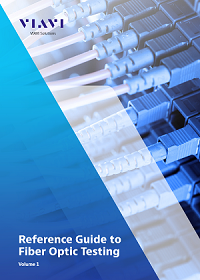
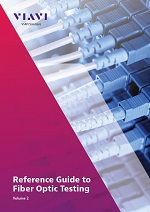
Besides
the FOA reference materials, two JDSU/VIAVI textbooks,
Reference Guide to Fiber Optic Testing, Volumes 1 and
2, were used as references for some of the FOA courses
and are recommended for instructors and students. The books
are available from VIAVI as eBooks and the everyone should
download them and recommend them to others.Download yours
now. Volume
1. Volume
2. Viavi Books
50th
Anniversary of The Development of Low Loss Fibers
A history of the development of low loss fiber, a
fascinating story by Jeff Hecht on the OSA (Optical Society
of America) website.
How
OFS Makes Fiber
Interesting YouTube video on how fiber is made. Perhaps a
little too much "show biz" but fascinating. If you have ever
seen fiber manufacture, look at this video. You will be
amazed at how big preforms have become!
How
Nexans Makes Copper Cables - compare the process
to fiber - don't most of the machines look similar?
The
True Cost of Telco Damages (what backhoe fade or
target practice can cost)
Rural
Electric Cooperatives: Pole Attachment Policies and
Issues, June 2019.
Clearfield-FOA
Certification Training Clearfield is now
offering their customers an FOA
CERTIFICATION course. This course provides
a basic understanding of fiber optic technology, as well
as Clearfield product knowledge and how Clearfield’s
integrated product systems work together in a fiber
network.
Substandard
Contractors - Fiber Optic Knowledge Doesn't Always
Trickle Down (EC Mag)
Another
Source Of Articles On Fiber
FOA
President and editor of this newsletter Jim Hayes has also
been writing a column in Electrical
Contractor Magazine for almost 20 years now.
Electrical contractors do lots of fiber work and this column
has covered some topics they are interested in including
installation processes, network design, fiber applications
and a lengthy series on dark fiber - what it is, how's its
used and how it benefits the growth of communication. A
recent web site redesign makes it easier to browse all these
articles - just go to http://www.ecmag.com/contributing-authors/jim-hayes
and you can see all of them. |
Q&A
Tech
Questions/Comments From FOA Newsletter Readers Worth
Repeating
The
FOA Fiber FAQs
Page (FAQs = frequently asked questions) gathers
up questions readers have asked us (which first ran in
this newsletter) and adds tech topics of general
interest.
|
Good
Question!
The
FOA Fiber FAQs
Page (FAQ s = frequently asked questions) gathers
up questions readers have asked us and adds tech topics
of general interest.
Questions
From FOA Newsletter Readers
October 2020
Last month's article about the installation
of a 6912 fiber cable in small conduit prompted a
number of this month's questions on social media. And there
were more too.
Re: Installation
of a 6912 fiber cable
Q: For this post, "Tight Fit: 6912 Fiber Cable
Pulled in 1.25 inch Conduit”, he asks if they can see one
end completely terminated?
A: It takes about 2 full racks of patch panels or one
rack of splice trays. Sumitomo shows the splicing rack here
https://global-sei.com/data-center-solutions/splicing-rack.html.
Most systems using these cables will buy fully populated
patch panel racks with a splice rack for the cable to splice
to 6912 fibers terminated in the rack.
Q: And a second question:: How long does it take to
terminate? And over how many panels?
A: A very experienced tech can splice one of these
cables in ~75-100 hours using ribbon splicing.
Q: I assume that's smaller fiber like 80 micron
cladding
A: All the fibers in the high fiber count cables are
made with regular singlemode fiber - 9/125micron. TO make
the cables smaller, the buffer coating diameter is reduced
to ~200microns to make the fibers smaller.
Q: How was it prepared with the splice tray and ODF?
It might require a dedicated panel and splice tray.
A: It takes about 2 full racks of patch panels or one
rack of splice trays. Most systems using these cables will
buy fully populated patch panel racks with a splice rack for
the cable to splice to 6912 fibers terminated in the rack.
Q: Is this an actual photo or was the cable installed
in a different type conduit.
A: We were told that is the actual size of the cable
and conduit although not of the actual installation
discussed.
Q: What is the minimum bend radius of that cable?
What procedures did they use to maintain that bend radius
through those 90 degree curves?
A: The minimum bend radius is 15X the cable diameter
for that cable (diameter 1.14” or 29mm), about 17” or
435mm. The conduit bends had to be controlled to be larger
than that radius.
Jobs In The Movie Industry
Q: Does anyone know if there are job positions in the
film industry that involve fiber optics? I started out
working in film with audio work with some camera as well. I
eventually transitioned into fiber optics installation and
testing. I've been trying to find out if there's a way to
find work that combines the two.
A: There are certainly jobs for fiber techs at the
film studios. We worked with a group 20 years ago to find
dark fiber in LA to connect studios to sound stages and
other facilities. Every studio now has fiber connections
everywhere, like this one at Paramount (below). I don’t know
where to look for jobs, but I’d guess it would be through
the unions - who represents the techs for the cameras,
monitors, etc.?
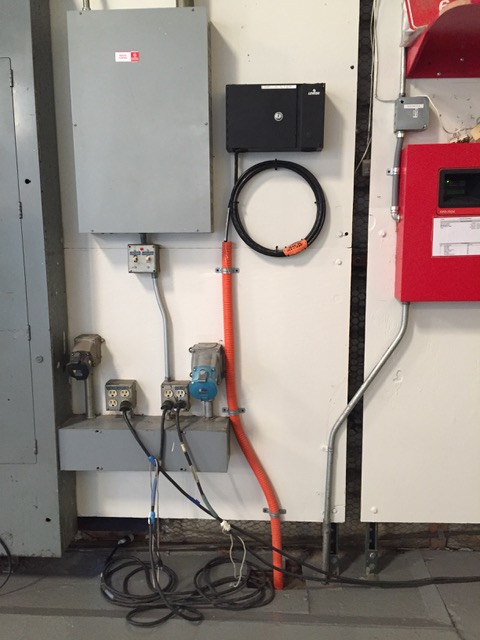
Preparing Cable For Splicing
Q: Is there any standard on the preparation length of
strip jacket upto the splice tray. Ideally its better to
have a loop of buffer before getting into the tray if ever
the closure has enough space for slack.. its also nice to
put some hose to the buffer to add on protection. So far, i
don't see any standard and can't support the remarks on what
to follow. The practice was to take note on macrobend and
have enough length of fiber to reach the machine.
A: There is a lot of variation in the size, shape
and design of splice closures, so the length varies
according to the closure and trays. For loose tube cable,
the length of buffer tube from the entrance to the splice
tray and the length of fiber needed in the tray are given in
the directions for that splice tray. Similarly for ribbon
cable, but the variations in ribbon cable designs often
requires special handling and sleeving for the ribbons. Most
manufacturers have specs available online.
Fusion Splice-On Connectors (SOCs) (From an FOA
Instructor)
Q: A question came up from one of our students
regarding splice on connectors. Is there a TIA or
other standards body that addresses this issue? We are used
to the 0.75 dB loss for a mated pair, however, when this
mated pair has two fusion splices that terminate the
connector, is there a recommendation?
One could make the argument that it does not make any
difference as the other alternative is splicing a pigtail
for termination of a cable. This pigtail splice is
normally included in the link loss budget
calculation. So similarly, with a splice on
connector it is the same as splicing on a pigtail.
A: There are no specific TIA or IEC specs that
address these splice-on connectors or pigtails. If you used
TIA numbers and included the splice and connector it would
be 1.05dB - 0.75dB for the connection and 0.3dB for the
splice, that’s mated to a factory adhesive/polish
connector. Or if it were two similar connectors,
1.35dB.
Everybody, including the people in TIA standards groups,
know those numbers are too high for most single ferrule
connectors. They keep them at 0.75dB for prepolished/splice
connectors (w/ mechanical splices) and array connectors
(MPOs) which have somewhat unpredictable performance.
Internationally, IEC has created grades of connectors from
~0.3 to over 1dB. The newer mechanical splice connector kits
now use the Chinese copied cleavers which are super - at
least the few we have tested - and the connectors are now
much lower loss and consistent.
SOCs (fusion splice-on connectors) are spec’ed as the total
termination and are generally just as good as the typical
adhesive polish connector - 0.5dB is plenty of margin for a
those mated to a factory adhesive/polish connector.
Spliced on pigtails are generally considered a termination
and the splice is not broken out - like a long SOC. But I
cannot guarantee everybody thinks that way. But a fusion
splice is typically <0.1dB anyway.
September
2020
Fiber Optic Regulations for Cable Markers
Q: I
wanted to inquire on any federal regulations there may be on
Cable Markers to alert citizens of fiber optic conduit
underneath the ground. We have had conflicts with installers
placing vertical white and orange markers in right-of-way in
residential areas
A: (Fron
Scott Landes, Rhino
Markers and
dp-PRO magazine) There are no regulations on
communications markers. Gas/Oil pipelines must be marked and
there are specifications for those markers. Curb markers can
be effective in residential areas. However they often do not
have a warning message telling people to call 811. They are
not as effective as marker posts, but if they are used along
with soil markers, which can be mowed over, you can create
an effective system.
Replace Coax With FIber
Q: I
read some of your interesting articles on network upgrades
and I was wondering if you can spare some suggestions.
I might be able to purchase an old non-pressurized
underground coaxial network, basically an old coaxial cable
inside a conduit. Is there any ‘cheap’ way to replace the
old coaxial cable with a new optic fiber cable, perhaps
simultaneously pulling out the old coaxial cable and pulling
a new fiber tube inside the old conduit?
A: If you own the conduit, it should be relatively
easy to remove the coax and replace it with fiber optics.
Our advice would be to pull the coax, pulling in a pull tape
as it is pulled out, clear the conduit and pull in the
largest microduct assembly you can - 6-7 12mm ducts is
usually only 40-50mm in diameter. Then you can blow in a
number of microcables. A 288 fiber cable in each duct adds
up to a lot of fiber or a lot of leasing to service
providers.
We also ran an article in a FOA
Newsletter "New Way To Install Fiber In Old Coax” that
describes how to replace the center conductor and dielectric
of the coax with fiber.
Testing Bare Fiber
Q:
I was wondering if there’s an equipment for a visual
fault locator but on a bare fiber cable. I know there’s a
bunch of VFL that needs an ST connector or LC connector to
use. I’m just wondering if there’s one for bare.
A: You can get a gadget called a “bare fiber adapter”
that allows you to strip the fiber, cleave it and clamp it
in a connector - then attach to a VFL or other source. If
you only have short lengths of fiber, you can probably get
by without cleaving the fiber as enough light will be
captured with a broken fiber.

The
word on the "Dig Once" program is getting out - FOA is
getting calls from cities asking us for information and
advice. Here are some links:
The DoT page on the administration’s Executive Order: http://www.fhwa.dot.gov/policy/otps/exeorder.cfm
From the Council of State governments: http://www.csg.org/pubs/capitolideas/enews/cs41_1.aspx
From the city of San Francisco: http://sfgov.org/dt/dig-once
An article about Dakota County, MN: https://muninetworks.org/tags/tags/dig-once
And
the one to download and hand out:
A “How To” Guide from The Global Connect Initiative: https://share.america.gov/wp-content/uploads/2016/04/6.-GCI-Dig-Once.pdf
Fiber Optic Cable Plant - The Finished Product 4/2020
In
April, FOA received inquiries from several sources that all
deal with the same subject - what is involved in the
specification and acceptance of a cable plant at the end of
a installation project. And what are reasonable
specifications for a cable plant.
FOA has a lot of documentation on a project involving
designing and installing a cable plant in the
FOA Online Guide and our Textbooks, but the acceptance
process has usually been relegated to a few paragraphs. We
decided to add a page
on project "Deliverables" in the FOA Guide that covers
this topic in more depth. This page looks at a project, goes
into some depth on loss budgets and includes links to FOA
tech documents to help you investigate further.
Correction: In the article, the original list of fiber
specs for G.652 was wrong. It should be 0.4dB/km @ 1310nm.
Deliverables
in the FOA Guide
Is
There A Standard For Fiber Optic Installation?
Another
question we get often is "Is there a standard for fiber
optic installation." The answer is yes, but not from the
usual standards groups you might expect. Over 20 years ago,
the National Electrical Contractors Association (NECA) asked
FOA to help create a standard for installation. That
standard, ANSI/NECA/FOA-301 has been updated three times
already and is about ready for another update.
Unlike most of those groups who charge you a fortune for
standards, FOA covers the cost so ANSI/NECA/FOA-301
is available free from FOA.

Download
your free copy of ANSI/NECA/FOA-301
here (PDF)
Older
questions are now available here.
|
Training /
FiberU
News and resources to help you learn more and stay
updated.
Find
a listing of all the FOA-Approved schools here.

Free
online self-study programs on many fiber optics
and cabling topics are available at Fiber
U, FOA's online web-based training website.
Free
online training at Fiber U
The
FOA has >100 videos on  |
New
Approach To Fiber Optic Labs - Sharing Test Equipment
Tom
Collins, Techtricians, FOA Director
Techtricians,
a FOA approved school, has taken a new approach in
how we provide lab training. Fifteen years ago, we developed
a hybrid training model had the participants complete online
(remote) lessons with face to face labs. Over the past 12
years trade organizations, colleges, vocational, vendor
training, and trade apprenticeships have adopted this model.
At the beginning of the pandemic we spent a lot of time,
energy, and money developing remote labs. We have
incorporated lessons learned from that process to restart
safe face to face labs.
First, we provide disposable materials and PPE’s for all
learning. Every student has their own work space with 8-9
feet of separation and their own set of hand tools only used
by the student. All of the classroom information is accessed
online or with USB drives. Our biggest challenge was how to
safely share testing equipment so every student could have
the practical hands on experience.
We believe we have found that solution with the help of “ezremote”.
The ezremote allows a multitude of students to have
practical exposure and experience with using a video
microscope, OLTS and OTDR testers. Every student can access
the remote via their own iPad or their smart phone, see
below picture and movie.
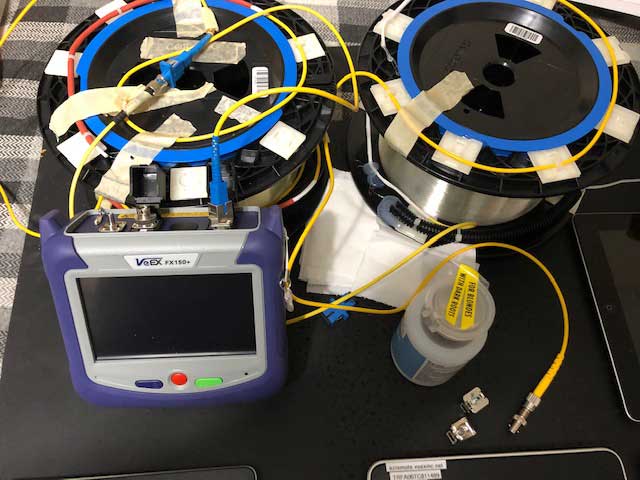
The VeEX OTDR set up for remote access in class
Recently, we contacted PCS, Inc. which is a premiere
manufacturer’s representative firm serving the Southeastern
US since 1974. Headquartered in Roswell, GA, Marc
Wright a sales representative spent a lot of time and
energy helping Techtricians to purchase the VeEX
FX150+ device. It is a full featured Mini OTDR with
high resolution sampling and intelligent link mapping for
Metro, Access and FTTx networks remote application. The
compact, lightweight platform incorporates built in WiFi,
power meter, light source, fiber inspection probe and VFL
test options which add exceptional versatility to the unit.
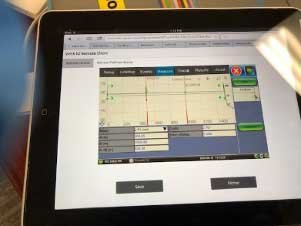 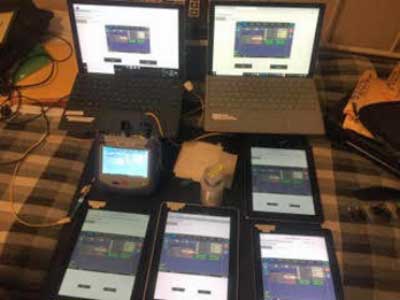
The remote OTDR displayed on an iPad (L) and on 4
smartphones and 2 laptops
In September we completed our first trial in a face to face
lab session in Lake Mary, Florida. The OTDR unit uses a WIFI
connection. The students went to the VeEX website with their
iPad or their smart phone and connected the to the base
unit. The lab module used one OTDR setup for the entire
class for testing the cable plant.
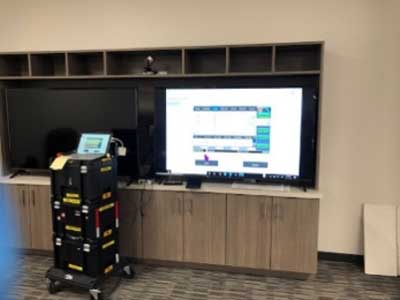
The instructor's laptop is connected to the OTDR and
projecting the display for everyone to see
The students when logged-in had control over the OTDR. Each
student saw the same screen which made the various events
much easier to explain. The module is very safe as the OTDR
is not touched by any student. The feedback we received from
the students was very positive. They provided suggestions
for future training modules. Even after the pandemic is
over, we will continue to use this new training method. Our
best teachers are our students and our hats are off to all
of our students.
For more information, contact Tom or Donna Collins at Techtricians.
New
Fiber U MiniCourses (September 2020)
Got
An Hour? Learn Something New About Fiber Optics.
Online
learning has been growing even more popular during the
pandemic, and FOA's Fiber U free online courses have
certainly been popular. We've just introduced a new type of
short course, one you can finish in an hour or less, that
covers a specific topic. The topics were easy to pick; they
are ones we're asked about often.
The courses have two components, video lectures and
readings, that are complementary. As usual there is a
self-test to allow you to check your comprehension. As with
other Fiber U courses if you desire, you can take a short
test for a Fiber U Certificate of Completion that costs
only $10.
The three new courses now available are "Fiber Optic
Restoration,' Connector Identification" and "The
Mysterious dB of Fiber Optics."
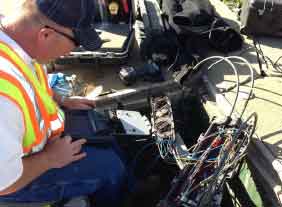
Fiber
Optic Network Restoration MiniCourse.
Every
fiber optic network is susceptible to outages, either by
damage to the cable plant or problems with the
communications equipment. This Fiber U MiniCourse covers
what kinds of damage occurs to a fiber optic
communications network, how to plan for outages and
restoration and how to troubleshoot and repair problems.
This course is aimed at managers and network owners as
well as contractors and installers.
If you are interested in restoration - aren't we all?
- you should also read this article in dpPro magazine
by FOA President Jim Hayes: Damage
Protection Requies Looking Overheas As Well As
Underground - dpPRO Magazine - about
the problems with aerial cables.
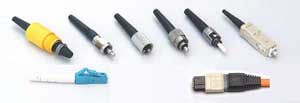
Fiber
Optic Connector Identification MiniCourse
Over
the history of fiber optics, there have been more than 100
unique designs for fiber optic connectors. Fortunately
only a few have become widely used, but field techs often
encounter connectors they are not familiar with and call
FOA for help. This Fiber U MiniCourse covers the most
popular connectors today and some that have been widely
used in the past that techs often contact FOA asking for
help in identifying them.
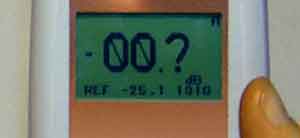
The
Mysterious dB of Fiber Optics MiniCourse
Fiber optic measurements of power
and loss are made in dB, a mysterious unit of
measurement that confuses many people. This
MiniCourse helps you understand what dB and dBm are,
how they are defined and measured. The course also
explains how small change in an international
standard created confusion and misunderstanding of
dB. Even if you aren't a math whiz, this FOA
MiniCourse can help you understand dB.
All these free courses and many more are
available at Fiber
U.
FOA
Schools
Welcome
To A New International School

Baseband
U, Corona, CA - FOA Approved School #384

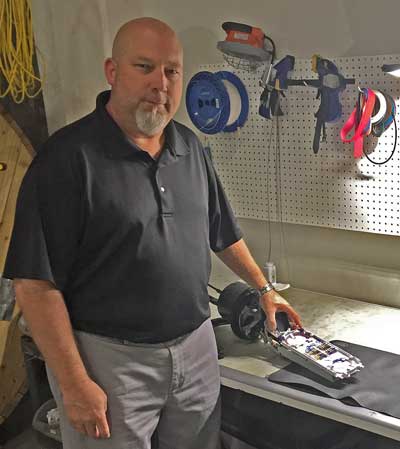
Jim
McConnell, FOA Certified Instructor, at the new school Baseband
U.
FOA
School BDI
Datalynk is offering classroom training with Covidd
precasutions and also remote classes over most of the US.
FOA
Master Instructor Eric Pearson of Pearson
Technologiesis now offering classroom training with
Covid precautions - 9/2020
Contact
Eric for details on his classes.
Classroom
Training Is Adapting To The Pandemic 8/2020
FOA
Director and instructor Tom Collins sent photos of his
recent IMSA/FOA CFOT class held in Florida. It shows how Tom
dresses for the job and how his students are social
distancing. More FOA classes are being held now using
techniques like these.

Instructor Tom Collins perpared to teach in the classroom.
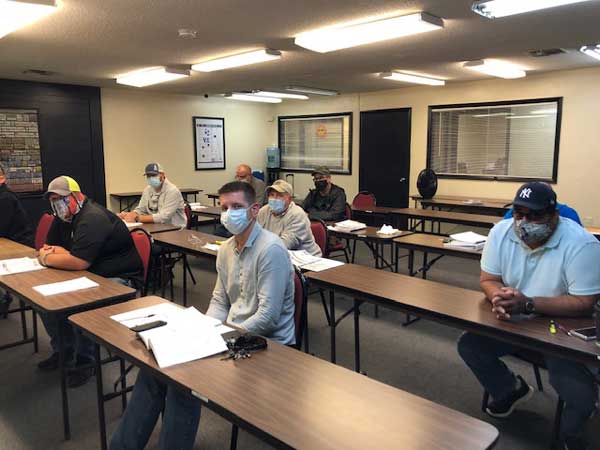
Students with appropriate distancing.
Training
Is Back - Made Safer (6/2020)
FOA
schools are starting to offer classes at their facilities
again to provide the personal interaction with an instructor
and hands-on labs, but some things have changed to provide
social distancing. Serge Rodrigue at Fibre
Zone in Quebec, Canada sent photos of his new lab
setup that includes individual lab stations with plexiglass
barriers.
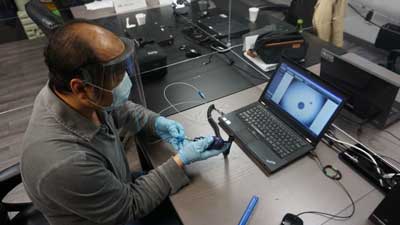
Students are following safe working protocols - masks and
gloves - to make classes safe and meet local government
requirements for social distancing.
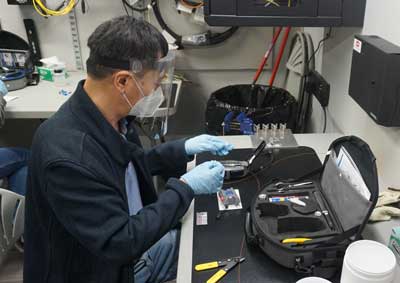
Contact Fibre
Zone in Quebec, Canada for
more information on their classes.
FiberNext in New Hampshire has also rearranged classrooms
for safer classes and has begun training in their facilities
in Concord, NH.
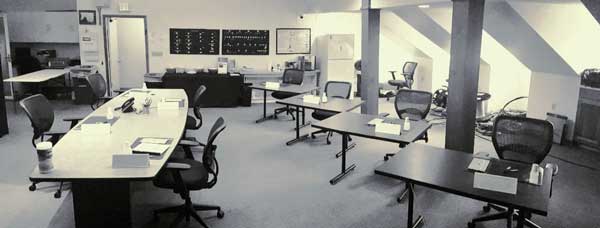
Contact FiberNext
in Concord, NH, USA or
more information on their classes. Also ask about joining
their CFOT
Club for savings on products and training.
Fiber
Optic Training Online - Simulations and Do-It-Yourself
Hands-On Training (6/20)
Simulating
Optical Loss Testing
FOA has been experimenting with simulations,
especially for testing since test equipment is
generally not inexpensive and requires a selection of
cables for reference test cables and cables to test.
We have had an OTDR Simulator based on the software
for an OTDR and a selection of traces for analysis.
Now we've created an optical loss simulator that uses
some web programming to allow stepping through the
process of setting up and testing a cable with a light
source and power meter.
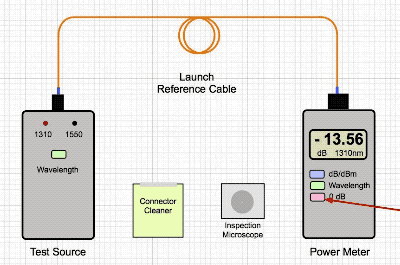
The simulation provides virtual meter and source,
inspection microscope, cleaners and a selection of
cables needed for testing. In the animation above you
can see one of the user interactions - the student
must use the proper button to set the "0dB" reference.
The loss simulator also requires the student use the FOA
Loss Budget Calculator to calculate the expected
loss of a cable under test, compare it to the measured
loss and make a Go/NoGo decision.
We even provide two versions of the simulator -
singlemode and multimode. The singlemode version tests
an OSP cable and then has the student compare OTDR
traces to troubleshoot problems. The multimode version
shows the effects of modal conditioning on multimode
measurements.
At the end, we've even added a wrap-up of the
techniques of loss testing and a quiz.
We added the loss simulator in the new Fiber
U DIY Basic Skills Lab for a virtual hands-on
testing lab.
Check out the FOA
Insertion Loss Simulator here.
DIY (Do-It-Yourself) Labs (6/20)
Knowledge
is easy to get online, but learning skills requires
"hands-on" practice and that requires tools and
components to practice with. Here at FOA, we've been
working on an online course that could help many
techs learn new skills or improve others using an
online self-study course and their own equipment. Recently,
we have updated the materials in the Fiber
U Fiber Optics Basic
Skills Labs which includes cable
preparation, splicing, termination and testing.
And we have created a Basic
Skills Labs - Copper Premises Cabling to
cover UTP (Cat 5) and coax copper cable
processes. As with all Fiber U courses, these
are free.
Several times in the FOA Newsletter we've discussed
the Fiber
U Basic Skills Lab. This online DIY lab course
assumes you have your own equipment to use for the
labs, but most novices, unless they work for a larger
company already in fiber optics, will not have
equipment. FOA instructors have found a solution:
purchase inexpensive equipment online. What they have
found are many low cost tools and components that are
perfectly suited to training.
If
you do not have tools or equipment and want to
purchase them, there is a new
Fiber U DIY Basic Skills Lab lesson with
directions on how to purchase inexpensive tools
online and use them to learn basic fiber optic
skills. Those tools and components are what we
describe here.
For example, you need a fiber cleaver
for splices and prepolished/splice connectors. A good
cleave is essential for a good splice or termination
with a splice-type connection. Good cleavers are now
available online at prices in the US starting at
$20US.
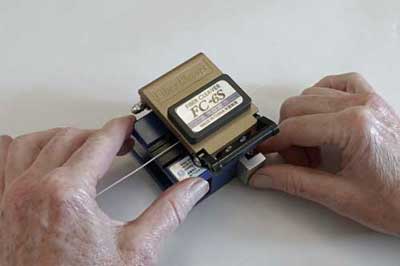
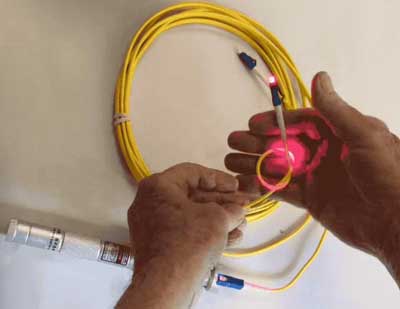
Besides the cleaver, another really good tool for
learning or teaching is a visual fault locator. These
devices used to be very expensive, but now are
available online for $10-20.
Many online sellers offer sets of fiber optic tools in
a kit for very low cost.
With plenty of tools available online, the next things
you need are components to practice on. No problem
here either. You need a patchcord, some mechanical
splices and some prepolished/splice connectors. The
connectors and splices are available from online
sellers for ~$1 each, easy to afford plenty to
practice on.
FOA has used all these available parts together into a
do-it-yourself
hands-on lab as part of the Fiber U Basic Skills
Lab. You can do this yourself at a very low
cost. We
even provide directions on how to search for
suppliers of these tools and components.
Caution!
FOA has not exhaustively tested these tools or
components enough to recommend them for field use. The
work we did with them to create teaching labs shows
they are certainly good enough to use for teaching the
installation processes in a training lab. We suggest
read the buyers reviews and do some of your own
testing before using them for anything other than
training and practice.
FOA
Guide "Basics Of Fiber Optics" Now Available in Portuguese
(6/2020)

FOA has
now translated the Basics of Fiber Optics textbook in our
Online Guide into Portuguese, joining Spanish and French
translations. For those speaking Portuguese, we have the
technical information and for schools we also have
curriculum available.
Here
is the FOA
Guide in Portuguese,
Spanish and
French
translations.
Time
To Learn - Online - (Update 4/5/6/8 2020)
Schools
have generally been closed during the pandemic lock-downs,
so FOA has been working with some of them to create new
online learning experiences that can in some cases lead to
certification online. FOA certifications are still based on
the KSAs - knowledge from the classroom, skills from the
labs and abilities judged by instructors or proven by actual
experience.
ZOOMing
Much of what we're doing benefits from the capabilities of
"Zoom." Others have created videoconferencing apps, but none
work so well, especially with limited bandwidth. We've seen
remote labs that have an instructor showing students how to
use the tools they were sent then watching them duplicate
their actions. We have worked out methods to use Zoom to
proctor FOA's online certification exams.
Blended
Learning
While most FOA schools have suspended in-person training
during this period, some are offering a "blended
learning" option. That means that students sign up for a
FOA certification course, take the classroom sessions on
Fiber U with the assistance of a FOA certified
instructor. Now online instruction can include reviewing
the labs using the Fiber
U Basic Skills Labs, then when it's possible to attend
classes at the school, complete the hands-on labs and
take the FOA certification exam.
Online Remote Labs
Alternatively, some schools are experimenting with
"remote labs," where the students get sent tool kits
and components and labs are conducted by
videoconferencing. Before the labs, the students may
watch demos by their instructor on videoconferencing
and/or review the relevant "virtual hands-on" lessons
in the Fiber U Fiber
Optics Basic
Skills Labs so they will already know
the steps in the exercises. And
Fiber U has the new
Fiber U DIY Basic Skills Lab lesson
with directions on how to purchase
inexpensive tools online and use them
to learn basic fiber optic skills. Videoconferencing
allows the instructor to remotely monitor their
work and provide help as needed. Contact
the FOA for more information.
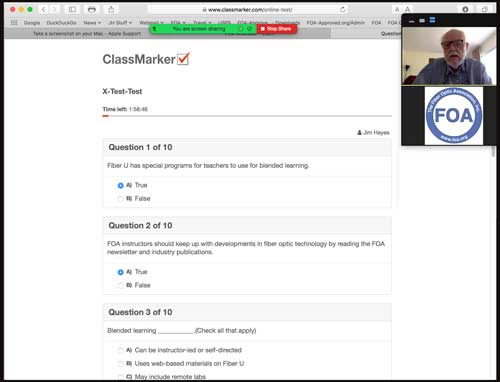
FOA Zoom Exam Proctoring
Online
Certification Testing
FOA has all its certification tests available
online, both for use by our schools and by our
direct "Work
to Cert" applicants. All FOA certification
tests require a proctor to oversee the applicant
taking the exam. In this time of social
distancing, getting a proctor can be difficult, so
FOA now has procedures for online proctors
administering the exam. Contact
the FOA for more information.
OJT - On-The-Job-Training
Many novices get a job and learn on the job. They
usually have an experienced tech who helps them gain the
knowledge and learn the skills they need to
perform their job. Thinking about this in relation to
the
FOA KSAs, the knowledge, skills and
abilities needed by a fiber optic tech, the tech
will learn skills but not the basic knowledge that helps
them understand the processes involved. FOA can offer
help here, using our Fiber
U online self-study programs. While the tech
learns on the job, they become a Fiber
U trainee, getting the knowledge they need,
while working under their "mentor" at work. This is
particularly good for contracting companies who need
techs but do not have the usual training courses
available. Interested in OJT programs? Contact FOA
for more information.
Can
You Learn Hands-On Skills Online?

Knowledge is easy to learn online, but learning skills
requires "hands-on" practice and that requires tools and
components to practice with. Here at FOA, we've been working
on an online course that could help many techs learn new
skills or improve others using an online self-study course
and their own equipment. Recently,
we have updated the materials in the Fiber
U Fiber Optics Basic
Skills Labs which includes cable preparation,
splicing, termination and testing. And we have created a
Basic
Skills Labs - Copper Premises Cabling to cover
UTP (Cat 5) and coax copper cable processes. As with
all Fiber U courses, these are free.

FOA offers free online self-study programs at Fiber
U. Many users are preparing for FOA certification
programs - taking courses at our schools or using the "Work-to-Cert"
program. Some of our schools are requiring Fiber U programs
as prerequisites for their classroom courses so they can
spend more time on hands-on activities.
New
FOA Approved School: Central
Electrical Training Center, FOA
School #656.
Find
a listing of all the FOA-Approved schools here.
FOA
School Offers Toolkit With Online Training
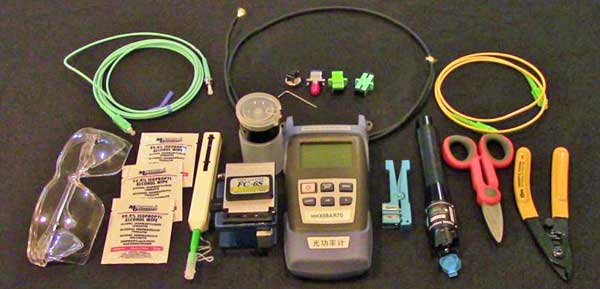
Slayton
Solutions (FOA Approved School #156) is offering a simple
fiber optic tool kit that includes a 29-piece set of fiber
optic tools and a power meter along with training videos
and online instruction for only $499. 29 Piece Kit
includes all tools and devices a technician needs to
install fiber optic connectors and test optical
power. Information
on the kit is available on YouTube.
You can contact them for more information at
slaytonsolutions@sbcglobal.net
or https://www.fiberopticsinstitute.com
|
Publications /
Resources

|
FOA
Loss Budget Calculator On A Web Page 5/2020
FOA has
written many articles about loss budgets, something everyone
involved in fiber optics needs to know and needs to know how
to calculate. We recently discovered how to get a
spreadsheet ported to a Web page, so we created this web
page that calculates loss budgets. We have an iOS loss
budget app, but with this web page, you can calculate loss
budgets from any device, smart phone, tablet, laptop, or
desktop computer that has web browsing capability.

Bookmark this page (especially on your smartphone): FOA
Loss Budget Calculator Online
 We are
continually updating the Online Reference Guide to keep up
with changes in the industry and adding lots of new pages of
technical information. When you go to the FOA
Guide Table of Contents to see the latest updates -
look for
We are
continually updating the Online Reference Guide to keep up
with changes in the industry and adding lots of new pages of
technical information. When you go to the FOA
Guide Table of Contents to see the latest updates -
look for  . .
Recent updates:
10GPON
on PON Protocols in the FOA Guide.
Coherent
Communications Systems in the FOA Guide.
Updated
(and more illustrations): Basic
Fiber Optic Jargon, OSP
Fiber
Optic Jargon and Fiber
Optic Jargon for managers.
Fiber
Optic Network Restoration
Fiber
Characterization goes in to more depth, why fiber
characterization is important and how to interpret results.
Fiber
Optic Network Management for managers
FOA
has created a section on OSP
Construction and a Fiber
U course based on it.
FOA
Guide section on inspecting and cleaning connectors.
Go
to The
FOA Online Fiber Optic Reference Guide.
FOA Reference Books
Available Printed or Kindle Books
The
fiber book is available in Spanish and French (printed) and
Portuguese (online). The design book is available in Spanish
(online)








FOA has
reprinted "Lennie
Lightwave's Guide" on its 25th anniversary in
a special print edition.
Lennie
and Uncle
Ted's Guides are online or as free iBooks on iTunes.


Click
on any of the books to learn more.
- Fiber
Optic Safety Poster to download and print
Resources
For Teachers In K-12 And Technical Schools
Teachers in all grades can introduce their students to
fiber optic technology with some simple demonstrations.
FOA has created a page for STEM or STEAM (science,
technology, engineering, arts
and math) teachers with materials appropriate to their
classes. Fiber
Optic Resources For Teachers.
|
Safety
|
On
Safety
FOA
considers safety an integral part of all our programs,
curriculum materials and technical materials. We start all
our textbooks and their online versions with a section on
safety in the first chapter, like this: Before
we get started - Safety First!
There are pages on the FOA Guide on Safety
procedures Including Eye Safety and. Digging
Safely
And a YouTube lecture: FOA
Lecture 2: Safety When Working With Fiber Optics
In our OSP Construction Section, these pages cover many
safety issues including those related to the construction of
the cable plant: Project
Preparation And Guidelines, Underground
Cable Construction, Underground
Cable Installation and Aerial
Cable Installation.
There is even a safety poster for the fiber activities: PDF
Safety Rules For Fiber Optics
The FOA is concerned about safety!
There
is a toll-free "call before you dig" number in the USA:
Dial 811
See
www.call811.com for
more information
The
Common Ground Alliance has an excellent "Best
Practices Guide" online
- The
US Department of Transportation has a website called "National
Pipeline Mapping System" that allows one to
search for buried pipelines.
Why
We Warn You To Be Careful About Fiber Shards

Photo courtesy Brian Brandstetter, Mississauga
Training Consultantcy
Safety
Leader Magazine
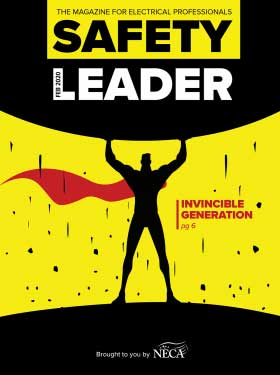
Safety Leader, a new quarterly magazine, informs and
educates electrical contractors on safety from various
angles—electrical, workplace, PPE, regulations, leadership,
line work, NFPA 70E, and more. Safety Leader is bundled with
ELECTRICAL CONTRACTOR in February, May, August and November.
To receive Safety Leader subscribe
to ELECTRICAL CONTRACTOR magazine here or subscribe
to the ELECTRICAL CONTRACTOR newsletter here.
2021
Conference On Damage Prevention Goes Virtual

2021
Global
Excavation Safety Conference VIRTUAL, taking
place April 6-8, 2021
More information in an article
in the dp-PRO announcing the Global Locate
Masters:
Website: www.GlobalLocateMasters.com
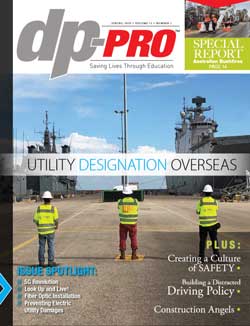
The magazine, dp-Pro, sponsor of the conference, has
also published it's latest issue with an article by FOA
on "New Construction Techniques in Fiber Optics" and a
overview of the FOA. You
can read the magazine here.
Best
Practices Guide For Underground Construction
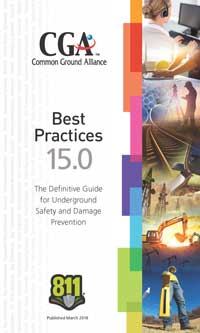
We
assume you are familiar with the "One Call" and "Call
Before You Dig" (811) program, but are you also
familiar "Click
Before You Dig.com" and with the people behind
it - the Common Ground Alliance and their Best Practices
website?
Officially
formed in 2000, the CGA represents a continuation of the
damage prevention efforts embodied by the Common
Ground Study.
Sponsored by the U.S. Department of Transportation and
completed in 1999, this Study represents the collaborative
work of 160 industry professionals who identified best
practices relating to damage prevention. Any
best practice or program endorsed by the CGA comes with
consensus support from experts representing the
following stakeholder groups: Excavators, Locators, Road
Builders, Electric, Telecommunications, Oil, Gas
Distribution, Gas Transmission, Railroad, One Call,
Public Works, Equipment Manufacturing, State Regulators,
Insurance, Emergency Services and Engineering/Design.
Read
the CGA Best Practices Guide here.
Here
are all the CGA resources for damage prevention.
The
US Department of Transportation has a website called "National
Pipeline Mapping System" that allows one to search
for buried pipelines. |
FOA/About
About
The FOA
- Contact
Us: http://www.foa.org
or email <info@foa.org>

FOA
has a company page and four LinkedIn Groups
FOA
- official company page on LinkedIn
FOA
- covers FOA, technology and jobs in the fiber optic
marketplace
FOA
Fiber Optic Training - open to all, covers fiber optic
technology and training topics
Grupo
de La Asociación de Fibra Óptica FOA (Español)
|
What is The FOA?
The FOA is a, international non-profit educational
association chartered to promote professionalism in fiber
optics through education, certification and standards.
Founded in 1995 by a dozen prominent fiber optics trainers
and leaders from education, industry
and government as
a professional society for fiber optics and a source of
independent certification, the FOA has grown to now being
involved in numerous activities to educate the world about
fiber optics and certify the workers who design, build and
operate the world's fiber optic networks.
FOA
is 25 years old this July - read about FOA's history in
this newsletter above.
Learn
More About FOA's History.
Contact
Us
The Fiber Optic Association Inc.
http://www.foa.org or email
<info@foa.org>
The
FOA Home Page

Want
to know more about fiber optics? Study
for FOA certifications? Free
Self-Study Programs are on "Fiber
U®." Looking for specific information? Here's the
largest technical reference on the web: The
FOA Online Fiber Optic Reference Guide.

Free
online self-study programs on many fiber optics and cabling
topics are available at Fiber
U, FOA's online web-based training website.
|
-
Contact
Us
The Fiber Optic Association Inc.
http://www.foa.org or email
<info@foa.org>
The
FOA Home Page
(C)1999-2020,
The Fiber Optic Association, Inc.
|
FOA
Logo Merchandise
New
FOA Swag! Shirts, Caps, Stickers, Cups, etc.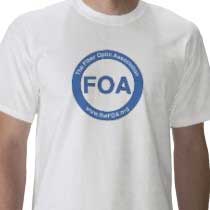
The FOA
has created a store on Zazzle.com offering lots of new logo
merchandise. It has lots of versions of shirts and other
merchandise with "FOA," "Fiber U," "Lennie Lightwave"
designs and more so you should find something just for you!
See FOA
on Zazzle.
-

Your
Name, CFOT® - It pays to advertise!
The
FOA encourages CFOTs to use the logo on their business
cards, letterhead, truck or van, etc. and provides logo
files for that purpose. But we are also asked about how to
use the CFOT or CFOS certifications. Easy, you can refer
to yourself as "Your Name, CFOT" or "Your Name, CFOS/T"
for example.
Feel
free to use the logo and designations to promote your
achievements and professionalism!
Contact
FOA at info@thefoa.org to get logos in file format for your
use.
Privacy
Policy (for the EU
GDPR): The FOA does not use cookies or any other
web tricks to gather information on visitors to our
website, nor do we allow commercial advertising. Our
website hosts may gather traffic statistics for the
visitors to our website and our online testing service,
ClassMarker, maintains statistics of test results. We do
not release or misuse any information on any of our
members except we will confirm FOA certifications and
Fiber U certificates of completion when requested by
appropriate persons such as employers or personnel
services.
Read
the complete FOA Privacy Policy here.
|







































































 .
.





